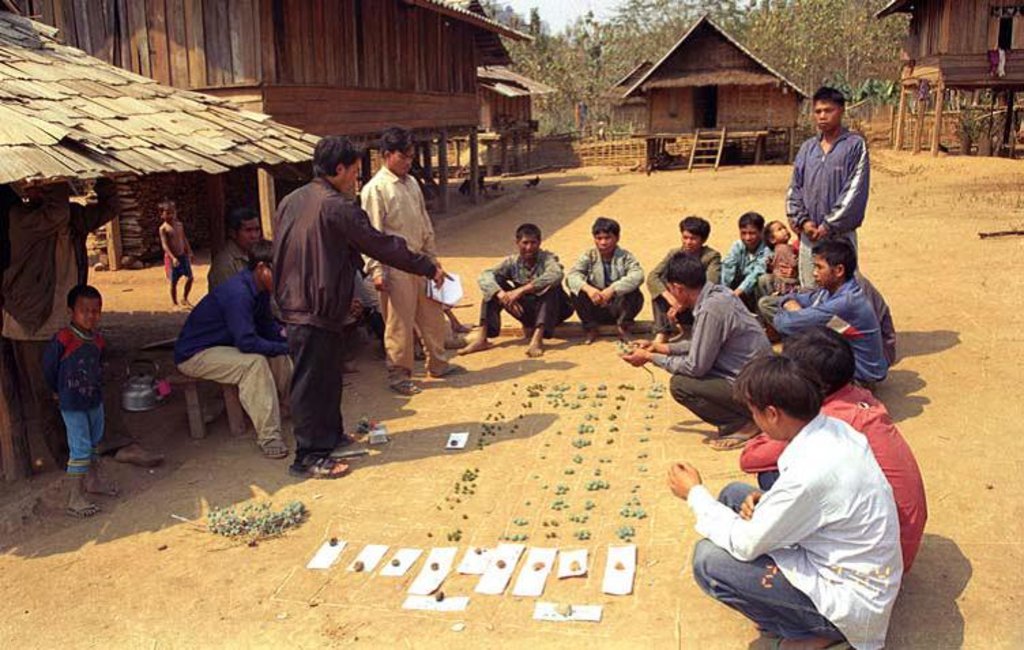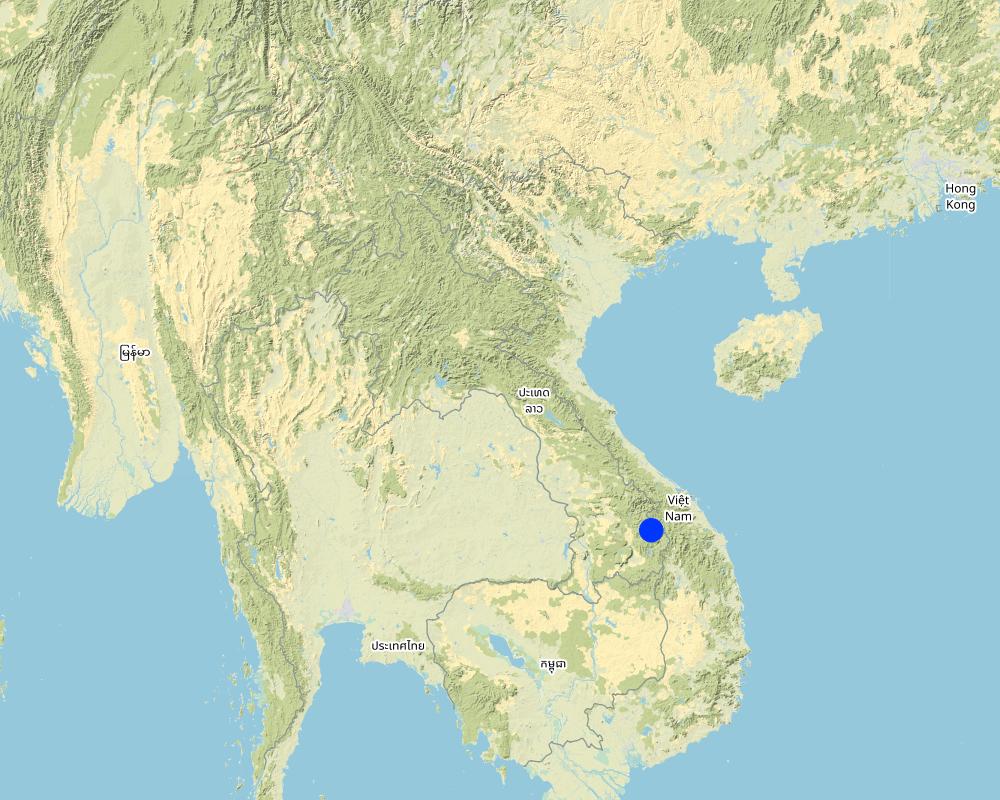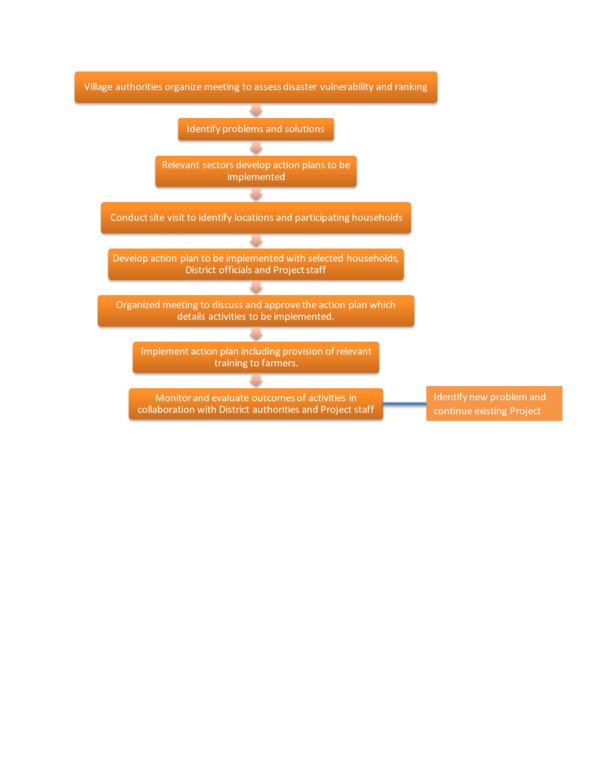Village Capacity and Vulnerability Assessment Project on Disaster Management [Laos]
- Création :
- Mise à jour :
- Compilateur : Pasalath Khounsy
- Rédacteurs : Bounthanom Bouahom, viengsavanh phimphachanhvongsod, kang phanvongsa
- Examinateurs : Nicole Harari, William Critchley, Joana Eichenberger
approaches_3877 - Laos
Voir les sections
Développer tout Réduire tout1. Informations générales
1.2 Coordonnées des personnes-ressources et des institutions impliquées dans l'évaluation et la documentation de l'Approche
Personne(s) ressource(s) clé(s)
Project manager:
Phasaveng Phounsy
+856 030 211582
phounsy.phasaveng@careint.org
CARE Office in Saravan
Laos
Nom du projet qui a facilité la documentation/ l'évaluation de l'Approche (si pertinent)
Scaling-up SLM practices by smallholder farmers (IFAD)Nom du ou des institutions qui ont facilité la documentation/ l'évaluation de l'Approche (si pertinent)
National Agriculture and Forestry Research Institute (NAFRI) - Laos1.3 Conditions relatives à l'utilisation par WOCAT des données documentées
Quand les données ont-elles été compilées (sur le terrain)?
25/08/2017
Le compilateur et la(les) personne(s) ressource(s) acceptent les conditions relatives à l'utilisation par WOCAT des données documentées:
Oui
2. Description de l'Approche de GDT
2.1 Courte description de l'Approche
The project is aimed at capacity building in disaster emergency response at district and village levels. It has applied a participation approach in planning and implementation. This included the identification of problems, SWOT analyses, implementation, and monitoring.
2.2 Description détaillée de l'Approche
Description détaillée de l'Approche:
Since 2012, after the Ketsana typhoon hit the southern provinces of Lao PDR, CARE International in Xekong Province has initiatives that address disaster reduction which are funded through various sources. The project is aimed at capacity building in disaster emergency response at district and village levels. DarkCheung district, one of the poorest districts of Xekong province, has established a Disaster Management Unit in five villages. The project was supported by Luxembourg’s Ministry of Foreign Affairs, Debeco, through the European Union. Most of the projects were relatively small and short duration, with approximately 2-3 years of project implementation. In 2017, Care International has also followed up existing activities with support from Debeco which are implemented in the three districts of Kaleum, DarkCheung, and Lamam, covering 16 villages. The aspects of the work that are relevant to the district office of agriculture include Disaster Vulnerability Assessment and Village Capacity Building. The main objectives of the project are to increase capacity in disaster management within local communities; increase food security, gender equality promotion in cooperation with local authorities, and increase awareness about disaster prevention. In principle, the project applied a participatory approach in planning and implementation. This included the identification of problems, SWOT analyses, implementation, and monitoring. The village and district authorities, as well as farmers, have been actively involved in project activities. It should be noted that the district authorities played an active role in community development. However, challenges remain, as Care International in Xekong province developed only short term projects, and this may affect outcomes and continuity of objectives in the future.
2.3 Photos de l'approche
2.5 Pays/ région/ lieux où l'Approche a été appliquée
Pays:
Laos
Région/ Etat/ Province:
Sekong Province
Autres spécifications du lieu :
Kaluem, Darkchueng and Lamam district
Commentaires:
CARE International Office in Sekong province
Map
×2.6 Dates de début et de fin de l'Approche
Indiquez l'année de démarrage:
2014
Si l'année précise est inconnue, indiquez approximativement quand l'Approche a démarré:
il y a moins de 10 ans (récemment)
2.7 Type d'Approche
- fondé sur un projet/ programme
2.8 Principaux objectifs de l'Approche
1. Strengthen capacity on disaster management at local levels;
2. Increase food security;
3. Promote gender equality amongst the local authorities; and
4. Increase awareness on disaster prevention.
2.9 Conditions favorisant ou entravant la mise en œuvre de la(des) Technologie(s) appliquée(s) sous l'Approche
normes et valeurs sociales/ culturelles/ religieuses
- entrave
Unsafe birth, gender and other issues are sensitive and need careful approach and understanding.
disponibilité/ accès aux ressources et services financiers
- entrave
cadre institutionnel
- favorise
collaboration/ coordination des acteurs
- favorise
Good cooperation and participation in implementation of activities amongst the villagers
cadre juridique (régime foncier, droits d'utilisation des terres et de l'eau)
- favorise
cadre politique
- favorise
gouvernance foncière (prise de décisions, mise en œuvre et application des décisions)
- favorise
connaissances sur la GDT, accès aux supports techniques
- favorise
Better coordination and understanding of district officials and village people.
marchés (pour acheter les intrants, vendre les produits) et prix
- entrave
charge de travail, disponibilité de la main-d'œuvre
- favorise
3. Participation et rôles des parties prenantes impliquées dans l'Approche
3.1 Parties prenantes impliquées dans l'Approche et rôles
- exploitants locaux des terres / communautés locales
Villagers or head of household participating in activities
Implementation, labour and material contribution as project needed
- organisations communautaires
Village authorities
Provide socio-economic information, encourage villagers to participate in the project
- Spécialistes de la GDT/ conseillers agricoles
CARE International staff in Xekong Province
- ONG
CARE, Oxfam, Save the Children, French Redcross
- gouvernement local
Provincial, district coordinators and technical staffs
Facilitate the coordination and strengthening local authorities and communities
3.2 Participation des exploitants locaux des terres/ communautés locales aux différentes phases de l'Approche
| Participation des exploitants locaux des terres/ communautés locales | Spécifiez qui était impliqué et décrivez les activités | |
|---|---|---|
| initiation/ motivation | interactive | The village, district, provincial authorities, and project staff to identify and assess disaster vulnerability and ranking in communities. |
| planification | interactive | The village, district, provincial authorities, and project staff involved in problem analysis and identified solutions, conducted site visits in the project location with participating households. Develop action plan, organize meeting to discuss and approve project activities. |
| mise en œuvre | interactive | The village, district and provincial authorities in collaboration with project staff provided training and implemented project activities together with farmers in target villages. In case of significant activity such as infrastructure development, the project staff will assist in the implementation. |
| suivi/ évaluation | interactive | All concerned stakeholders were involved in project monitoring in each phase. |
| interactive | Allow each stakeholders summarize project implementation outcomes, and discuss issues and identify solutions for future actions. |
3.3 Diagramme/ organigramme (si disponible)
3.4 Prises de décision pour la sélection de la Technologie/ des Technologies
Indiquez qui a décidé de la sélection de la Technologie/ des Technologies à mettre en œuvre:
- tous les acteurs concernés dans le cadre d'une approche participative
Spécifiez sur quelle base ont été prises les décisions:
- l'évaluation de connaissances bien documentées en matière de GDT (prises de décision fondées sur des preuves tangibles)?
- expériences et opinions personnelles (non documentées)
4. Soutien technique, renforcement des capacités et gestion des connaissances
4.1 Renforcement des capacités/ formation
Une formation a-t-elle été dispensée aux exploitants des terres/ autres parties prenantes?
Oui
Spécifiez qui a été formé:
- exploitants des terres
- personnels/ conseillers de terrain
Formats de la formation:
- sur le tas
- entre agriculteurs (d'exploitants à exploitants)
- réunions publiques
- cours
Thèmes abordés:
General knowledge on disaster prevention, disaster preparedness and emergency response, forest and environmental protection
4.2 Service de conseils
Les exploitants des terres ont-ils accès à un service de conseils?
Oui
Spécifiez si le service de conseils est fourni:
- dans les champs des exploitants?
Décrivez/ commentez:
In addition, there were monitoring missions from village, district and provincial authorities. In case of an emergency situation, coordination was through mobile phones.
4.3 Renforcement des institutions (développement organisationnel)
Des institutions ont elles été mises en place ou renforcées par le biais de l'Approche?
- oui, modérément
Spécifiez à quel(s) niveau(x), ces institutions ont été renforcées ou mises en place:
- local
Décrivez l'institution, ses rôles et responsabilités, ses membres, etc.
There were monitoring teams representing the village and district, and a village notice board.
Précisez le type de soutien:
- financier
- renforcement des capacités/ formation
- équipement
4.4 Suivi et évaluation
Le suivi et l'évaluation font ils partie de l'Approche? :
Oui
Commentaires:
The CARE -Xekong M&E team collaborated with the through use of village notice boards in the village and district.
Si oui, ce document est-il destiné à être utilisé pour le suivi et l'évaluation?
Non
4.5 Recherche
La recherche a-t-elle fait partie intégrante de l’Approche?
Non
5. Financement et soutien matériel externe
5.1 Budget annuel de la composante GDT de l'Approche
Si le budget annuel précis n'est pas connu, indiquez une fourchette:
- 100 000-1 000 000
Commentez (par ex. principales sources de financement/ principaux bailleurs de fonds):
Multiple funding sources including Debego for humanitarian aid, European Union (EU), Ministry of Foreign Affairs of Luxembourg
5.2 Soutiens financiers/ matériels fournis aux exploitants des terres
Les exploitants des terres ont-ils reçu un soutien financier/ matériel pour la mise en œuvre de la Technologie/ des Technologies?
Non
5.3 Subventions pour des intrants spécifiques (incluant la main d'œuvre)
- main d'œuvre
| Dans quelle mesure | Spécifiez les subventions |
|---|---|
| entièrement financé |
Si la main d'œuvre fournie par les exploitants des terres était un intrant substantiel, elle était:
- volontaire
Commentaires:
Project provided lunch and villagers shared labour
5.4 Crédits
Des crédits ont-ils été alloués à travers l'Approche pour les activités de GDT?
Non
5.5 Autres incitations ou instruments
D'autres incitations ou instruments ont-ils été utilisés pour promouvoir la mise en œuvre des Technologies de GDT?
Non
6. Analyses d'impact et conclusions
6.1 Impacts de l'Approche
Est-ce que l'Approche a autonomisé les exploitants locaux des terres, amélioré la participation des parties prenantes?
- Non
- Oui, un peu
- Oui, modérément
- Oui, beaucoup
The project has strengthened local communities to work together from planning, implementing, and monitoring approaches.
Est-ce que l'Approche a aidé les exploitants des terres à mettre en œuvre et entretenir les Technologies de GDT?
- Non
- Oui, un peu
- Oui, modérément
- Oui, beaucoup
Est-ce que l'Approche a amélioré la coordination et la mise en œuvre de la GDT selon un bon rapport coût-efficacité?
- Non
- Oui, un peu
- Oui, modérément
- Oui, beaucoup
Est-ce que l'Approche a mobilisé/ amélioré l'accès aux ressources financières pour la mise en œuvre de la GDT?
- Non
- Oui, un peu
- Oui, modérément
- Oui, beaucoup
Est-ce que l'Approche a amélioré les connaissances et les capacités des exploitants des terres pour mettre en œuvre la GDT?
- Non
- Oui, un peu
- Oui, modérément
- Oui, beaucoup
Est-ce que l'Approche a amélioré les connaissances et les capacités des autres parties prenantes?
- Non
- Oui, un peu
- Oui, modérément
- Oui, beaucoup
Est-ce que l'Approche a construit/ renforcé les institutions, la collaboration entre parties prenantes?
- Non
- Oui, un peu
- Oui, modérément
- Oui, beaucoup
Est-ce que l'Approche a atténué les conflits?
- Non
- Oui, un peu
- Oui, modérément
- Oui, beaucoup
Est-ce que l'Approche a autonomisé les groupes socialement et économiquement défavorisés?
- Non
- Oui, un peu
- Oui, modérément
- Oui, beaucoup
The project has assisted the disabled groups, divorced women with many children, households with lack of productive labours who were all prioritized as project beneficiaries.
Est-ce que l'Approche a amélioré l'égalité entre hommes et femmes et autonomisé les femmes et les filles?
- Non
- Oui, un peu
- Oui, modérément
- Oui, beaucoup
The project has increased awareness on women’s rights.
Est-ce que l'Approche a encouragé les jeunes/ la prochaine génération d'exploitants des terres à s'engager dans la GDT?
- Non
- Oui, un peu
- Oui, modérément
- Oui, beaucoup
Est-ce que l'Approche a amélioré les questions foncières et des droits d'utilisation qui entravent la mise en œuvre des Technologies?
- Non
- Oui, un peu
- Oui, modérément
- Oui, beaucoup
Est-ce que l'Approche a conduit à améliorer la sécurité alimentaire et/ou la nutrition?
- Non
- Oui, un peu
- Oui, modérément
- Oui, beaucoup
Est-ce que l'Approche a amélioré l'accès aux marchés?
- Non
- Oui, un peu
- Oui, modérément
- Oui, beaucoup
The project activities are linked to food security.
Est-ce que l'Approche a conduit à améliorer l'accès à l'eau et l'assainissement?
- Non
- Oui, un peu
- Oui, modérément
- Oui, beaucoup
After the Ketsana typhoon, the project has supported the repair of 3 – 4 gravity fed water supply systems in 16 villages.
Est-ce que l'Approche a conduit à l'utilisation/ sources d'énergie plus durables?
- Non
- Oui, un peu
- Oui, modérément
- Oui, beaucoup
The project has suggested the use of solar voltage power systems in areas without connection to main power grids in 10 villages in Kaleum and DarkCheung district
Est-ce que l'Approche a amélioré la capacité des exploitants des terres à s'adapter aux changements/ extrêmes climatiques et a atténué les catastrophes liées au climat?
- Non
- Oui, un peu
- Oui, modérément
- Oui, beaucoup
Est-ce que l'Approche a conduit à des emplois, des opportunités de revenus?
- Non
- Oui, un peu
- Oui, modérément
- Oui, beaucoup
6.2 Principale motivation des exploitants des terres pour mettre en œuvre la GDT
- réduire la dégradation des terres
- réduire les risques de catastrophe
- conscience environnementale
- améliorer les connaissances et compétences en GDT
6.3 Durabilité des activités de l'Approche
Les exploitants des terres peuvent-ils poursuivre ce qui a été mis en œuvre par le biais de l'Approche (sans soutien extérieur)?
- oui
Si oui, décrivez de quelle manière:
The district and village authorities have some basic understanding about disaster responses.
6.4 Points forts/ avantages de l'Approche
| Points forts/ avantages/ possibilités du point de vue de l'exploitant des terres |
|---|
| Strengthening capacity of village, district and provincial authorities (Committees for Disaster Prevention and Control) particularly after Ketsana typhoon. |
| Communities gain knowledge and are able to identify problem and develop action plans on disaster management. |
| The project has implemented activities that provided benefits to the public such as: disaster warning, rainwater storage, precipitation station. |
| Supported high frequency radio system instead of mobile phones. |
| Points forts/ avantages/ possibilités du point de vue du compilateur ou d'une autre personne ressource clé |
|---|
| Disaster management is an important aspect that needs to be implemented in all regions. |
| Local communities and other stakeholders were actively participated in the project. |
| The project helped to identify key problems and strengthen capacity to ensure regular and continuous monitoring of activities although it had only one-year lifespan. The project adopted M&E framework from similar projects in order to effectively monitoring this project. |
6.5 Faiblesses/ inconvénients de l'Approche et moyens de les surmonter
| Faiblesses/ inconvénients/ risques du point de vue de l’exploitant des terres | Comment peuvent-ils être surmontés? |
|---|---|
| The disaster management projects had short term lifespan but there were considerable needs and expectations from communities, and the lack of sufficient funding. | |
| The MOU signing process for disaster related projects took long time between the government and NGOs which caused delayed in project implementation. | The need to have better coordination on the review and approve the MOU document between the two parties. |
| Faiblesses/ inconvénients/ risques du point de vue du compilateur ou d'une autre personne ressource clé | Comment peuvent-ils être surmontés? |
|---|---|
| The GOL has yet identified vulnerable areas to certain disasters and there are still a lack of funding allocation to meeting the needs. | The need to identify appropriate vulnerable areas including high vulnerability, warning areas and among others. |
| Most projects were managed by non-profit organizations and typically have short-term lifespan and limited staff. | The need to develop long-term planning with multi-funding organizations. |
7. Références et liens
7.1 Méthodes/ sources d'information
- interviews/ entretiens avec les spécialistes/ experts de GDT
2
Liens et modules
Développer tout Réduire toutLiens
Aucun lien
Modules
Aucun module trouvé





